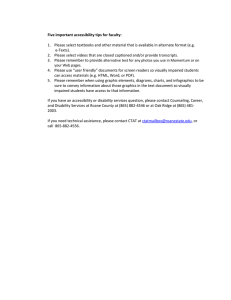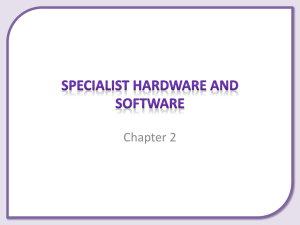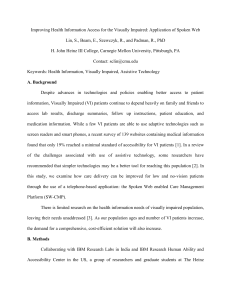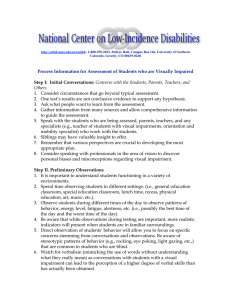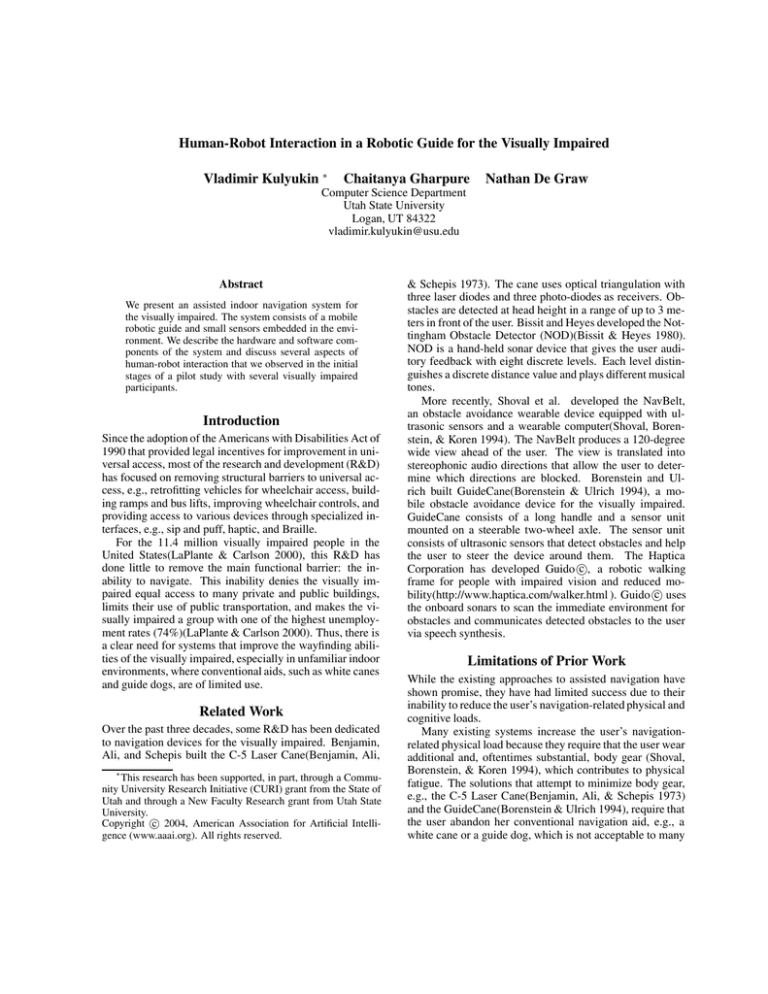
Human-Robot Interaction in a Robotic Guide for the Visually Impaired
Vladimir Kulyukin ∗
Chaitanya Gharpure
Computer Science Department
Utah State University
Logan, UT 84322
vladimir.kulyukin@usu.edu
Abstract
We present an assisted indoor navigation system for
the visually impaired. The system consists of a mobile
robotic guide and small sensors embedded in the environment. We describe the hardware and software components of the system and discuss several aspects of
human-robot interaction that we observed in the initial
stages of a pilot study with several visually impaired
participants.
Introduction
Since the adoption of the Americans with Disabilities Act of
1990 that provided legal incentives for improvement in universal access, most of the research and development (R&D)
has focused on removing structural barriers to universal access, e.g., retrofitting vehicles for wheelchair access, building ramps and bus lifts, improving wheelchair controls, and
providing access to various devices through specialized interfaces, e.g., sip and puff, haptic, and Braille.
For the 11.4 million visually impaired people in the
United States(LaPlante & Carlson 2000), this R&D has
done little to remove the main functional barrier: the inability to navigate. This inability denies the visually impaired equal access to many private and public buildings,
limits their use of public transportation, and makes the visually impaired a group with one of the highest unemployment rates (74%)(LaPlante & Carlson 2000). Thus, there is
a clear need for systems that improve the wayfinding abilities of the visually impaired, especially in unfamiliar indoor
environments, where conventional aids, such as white canes
and guide dogs, are of limited use.
Related Work
Over the past three decades, some R&D has been dedicated
to navigation devices for the visually impaired. Benjamin,
Ali, and Schepis built the C-5 Laser Cane(Benjamin, Ali,
∗
This research has been supported, in part, through a Community University Research Initiative (CURI) grant from the State of
Utah and through a New Faculty Research grant from Utah State
University.
c 2004, American Association for Artificial IntelliCopyright gence (www.aaai.org). All rights reserved.
Nathan De Graw
& Schepis 1973). The cane uses optical triangulation with
three laser diodes and three photo-diodes as receivers. Obstacles are detected at head height in a range of up to 3 meters in front of the user. Bissit and Heyes developed the Nottingham Obstacle Detector (NOD)(Bissit & Heyes 1980).
NOD is a hand-held sonar device that gives the user auditory feedback with eight discrete levels. Each level distinguishes a discrete distance value and plays different musical
tones.
More recently, Shoval et al. developed the NavBelt,
an obstacle avoidance wearable device equipped with ultrasonic sensors and a wearable computer(Shoval, Borenstein, & Koren 1994). The NavBelt produces a 120-degree
wide view ahead of the user. The view is translated into
stereophonic audio directions that allow the user to determine which directions are blocked. Borenstein and Ulrich built GuideCane(Borenstein & Ulrich 1994), a mobile obstacle avoidance device for the visually impaired.
GuideCane consists of a long handle and a sensor unit
mounted on a steerable two-wheel axle. The sensor unit
consists of ultrasonic sensors that detect obstacles and help
the user to steer the device around them. The Haptica
c a robotic walking
Corporation has developed Guido ,
frame for people with impaired vision and reduced moc uses
bility(http://www.haptica.com/walker.html ). Guido the onboard sonars to scan the immediate environment for
obstacles and communicates detected obstacles to the user
via speech synthesis.
Limitations of Prior Work
While the existing approaches to assisted navigation have
shown promise, they have had limited success due to their
inability to reduce the user’s navigation-related physical and
cognitive loads.
Many existing systems increase the user’s navigationrelated physical load because they require that the user wear
additional and, oftentimes substantial, body gear (Shoval,
Borenstein, & Koren 1994), which contributes to physical
fatigue. The solutions that attempt to minimize body gear,
e.g., the C-5 Laser Cane(Benjamin, Ali, & Schepis 1973)
and the GuideCane(Borenstein & Ulrich 1994), require that
the user abandon her conventional navigation aid, e.g., a
white cane or a guide dog, which is not acceptable to many
visually impaired individuals.
The user’s navigation-related cognitive load remains
high, because the user makes all final navigation decisions.
Device-assisted navigation focuses on obstacle avoidance
but provides little cognitive improvement over its conventional counterparts, i.e., canes and guide dogs.
Robot-Assisted Navigation
Robot-assisted navigation can help the visually impaired
overcome these limitations. First, the amount of body gear
carried by the user is significantly minimized, because most
of it can be mounted on the robot and powered from onboard batteries. Consequently, the navigation-related physical load is significantly reduced. Second, the user can interact with the robot in ways unimaginable with guide dogs
and white canes, i.e., speech, wearable keyboard, audio, etc.
These interaction modes make the user feel more at ease
and reduce her navigation-related cognitive load. Third, the
robot can interact with other people in the environment, e.g.,
ask them to yield or receive instructions. Fourth, robotic
guides can carry useful payloads, e.g., suitcases and grocery
bags. Finally, the user can use robotic guides in conjunction
with her conventional navigation aids.
Are all environments suitable for robotic guides? No.
There is little need for such guides in familiar environments
where conventional navigation aids are adequate. However,
unfamiliar environments, e.g., airports, conference centers,
and office spaces, are a perfect niche for robotic guides.
Guide dogs, white canes, and other navigation devices are
of limited use in such environments because they cannot
help their users find paths to useful destinations.
The idea of robotic guides is not new. Horswill(Horswill
1993) used the situated activity theory to build Polly, a mobile robot guide for the MIT AI Lab. Polly used lightweight
vision routines that depended on textures specific to the lab.
Thrun et al.(Thrun et al. 1999) built Minerva, a completely
autonomous tour-guide robot that was deployed in the National Museum of American History in Washington, D.C.
Unfortunately, neither project addresses the needs of the
visually impaired. Both depend on the users’ ability to
maintain visual contact with the guides, which cannot be
assumed for the visually impaired. Polly has very limited
interaction capabilities: the only way users can interact with
the system is by tapping their feet. In addition, the approach
on which Polly is based requires that a robot be evolved
by its designer to fit its environment not only in terms of
software but also in terms of hardware. This makes it difficult to develop robotic guides that can be deployed in new
environments, e.g., conference halls, in a matter of hours
by technicians who know little about robotics. Completely
autonomous solutions like Minerva that attempt to do everything on their own are expensive and require substantial investments in customized engineering to become operational, which makes them hard to reproduce.
Figure 1: RG.
Figure 2: RG guiding a visually impaired person.
We refer to the approach behind RG as non-intrusive instrumentation of man-made environments. The idea is to instrument the environment with inexpensive and reliable sensors
in such a way that no activities indigenous to that environment are disrupted. Additional requirements are that the
instrumentation be fast and require only commercial-offthe-shelf (COTS) hardware components. Effectively, the
environment becomes a distributed tracking and guidance
system (Kulyukin & Blair 2003) that consists of stationary
nodes, i.e., computers and sensors, and mobile nodes, i.e.,
robotic guides.
Hardware
RG is built on top of the Pioneer 2DX commercial robotic
platform (http://www.activmedia.com ) (See Figure 1). The
platform has three wheels, 16 ultrasonic sonars, 8 in front
and 8 in the back, and is equipped with three rechargeable
Power Sonic PS-1270 onboard batteries that can operate for
up to 10 hours at a time.
A Robotic Guide
We have built a prototype of a robotic guide for the visually
impaired. Its name is RG, which stands for “robotic guide.”
Figure 3: An RFID tag attached to a wall.
What turns the platform into a robotic guide is a Wearable Wayfinding Toolkit (WWT) mounted on top of the
platform and powered from the on-board batteries. As can
be seen in Figure 1, the WWT resides in a PCV pipe structure attached to the top of the platform. The WWT’s core
component is a Dell Inspiron I820 laptop connected to the
platform’s microcontroller. The laptop has a Pentium 4 mobile 1.6 GHz processor with 512 MB of RAM. Communication between the laptop and the microcontroller is done
through a TrippLite USB to Serial cable. The laptop has
an Orinoco Gold PC Card 802.11b wireless card that allows
for remote wireless connectivity.
The laptop interfaces to a radio-frequency identification
(RFID) reader through another USB to Serial cable. The TI
Series 2000 RFID reader is connected to a square 200mm
by 200mm RFID RI-ANT-GO2E antenna that detects RFID
tags placed in the environment. In Figure 1, the arrow in the
top left corner points to the RFID antenna; the arrow in the
bottom right corner points to the RFID reader behind the
laptop’s screen. The arrow in Figure 3 points to a TI RFID
Slim Disk tag attached to a wall.
These tags can be attached to any objects in the environment or worn on clothing. They do not require any external
power source or direct line of sight to be detected by the
RFID reader. They are activated by the spherical electromagnetic field generated by the RFID antenna with a radius
of approximately 1.5 meters. Each tag is programmatically
assigned a unique ID. A dog leash is attached to the battery
bay handle on the back of the platform. The upper end of
the leash is hung on a PCV pole next to the RFID antenna’s
pole. Visually impaired individuals follow RG by holding
onto that leash. Figure 2 shows a visually impaired person
following RG.
Software
RG is implemented as a distributed system. The WWT laptop runs the following low-level robotic routines: followwall, avoid-obstacles, go-thru-doorway, pass-doorway, and
make-hallway-uturn. These routines are written in the behavior programming language of the ActivMedia Robotics
Interface for Applications (ARIA) system from ActivMedia
Robotics, Inc. The laptop also runs a speech recognition
and synthesis engine that enables RG to receive and synthesize speech, the Map Server, and the Path Planner. The
advantages and disadvantages of speech-based interaction
are discussed in the next section.
The Map Server is implemented as an OpenCyc server
(http://www.opencyc.org ). The server’s knowledge base
represents an aerial view of the environment in which RG
operates. Currently, the knowledge base consists of floor
maps, tag to destination mappings, and low-level action
scripts associated with specific tags. The base also registers the latest position of RG, which is sent there as soon as
a tag is detected in the environment.
The environment is represented as a graph where nodes
represent the RFID tags and the edges represent the actions
required to travel from one tag to another. Since RG is designed to follow the right wall, the graph is directed. For ex-
ample, the following assertion in the OpenCyc’s knowledge
representation language CYCL represents a graph node:
(#$rfidTag 5
(#$TheList
(#$TheList 82
(#$sMakeHallwayUturn)
(#$sFollowWall 1))
(#$TheList 6
(#$sGoThruDoorway)
(#$sFollowWall 1)))
(#$TheList 4))
This assertion states that this node is represented by the
RFID tag whose ID is 5. Second argument to the predicate
#$rfidTag is a list of nodes that can be reached from
node 5. In this example, from node 5 one can reach nodes
82 and 6. Each reachable node has a sequence of actions
associated with it. A single action is represented by a predicate, such as #$sFollowWall. The only argument to the
$sFollowWall predicate is 0 or 1 with 0 standing for the
left wall and 1 standing for the right wall. In the above example, tag 82 can be reached from tag 5 by first making a
hallway u-turn and then following the right wall until tag 82
is detected. Similarly, tag 6 can be reached from tag 5 by
first going through a doorway and then following the right
wall.
Of course,
action specifications,
such as
#$sFollowWall, are robot-specific.
In selecting
actions, we tried to find a minimal action set that can
be used in many standard indoor environments. As
new actions are developed for new environments, they
can be easily specified in this knowledge formalism.
Other platforms can use this formalism to describe their
platform-specific actions.
The tag to destination mappings are represented by assertions such as the following:
(#$tag-destination
#$John.Doe 23
(#$TheList (#sPassDoorway)))
In this assertion, tag 23 corresponds to John
Doe’s office.
The third argument to the predicate
#$tag-destination represents a possibly empty
sequence of actions to be taken before stopping, once the
destination tag has been detected. For example, in the
above example, once RG has detected tag 23, it continues to
move until the doorway is passed regardless of whether the
door is open or closed. Such actions allow RG to position
itself at a destination in such a way that the destination
is easily accessible to the visually impaired user. For
example, RG always moves past the door of a desired office
so that when it stops the visually impaired user is at the
door.
The Path Planner uses the standard breadth first search
algorithm to find a path from one location to the other. The
Planner uses the Map Server for the graph connectivity information and generates a path plan in the form of a sequence of tag numbers and action sequences at each tag.
Human-Robot Interaction
Humans can interact with RG either through speech or
GUIs. Currently, speech-based interaction is intended for
visually impaired individuals. Speech is received by RG
through a wireless microphone placed on the user’s clothing. Speech is recognized and synthesized with Microsoft
Speech API (SAPI) 5.1, which is freely available from
www.microsoft.com/speech. SAPI includes the Microsoft
English SR Engine Version 5, a state-of-the-art Hidden
Markov Model speech recognition engine. The engine includes 60,000 English words, which we found adequate for
our purposes.
SAPI couples the Hidden Markov Model speech recognition with a system for constraining speech inputs with
context-free command and control grammars. The grammars constrain speech recognition sufficiently to eliminate user training and provide speaker-independent speech
recognition. This ability to constrain speech input was an
important consideration for our system, because visually
impaired people need to be able to interact with robotic
guides in situations that offer no training opportunities.
Grammars are defined with XML Data Type Definitions
(DTDs). Below is a truncated rule from the context-free
grammar used in the system.
<RULE NAME="RGActions"
<L> <P>wake up R G</P>
<P>what can i say</P>
<P>where am i</P>
<P>stop guide</P>
</L>
</RULE>
GUI-based interactions are reserved for system administrators. The notion of a system administrator is construed
rather broadly. It can be a technician installing the system
or an administrative assistant telling the system that a specific region is blocked for two hours due to a special event.
For example, a system administrator can place an RFID tag
on a new object in the environment, i.e., a soda machine,
and add a new tag-object pair to the OpenCyc knowledge
base. Such updates prompt administrators for brief written
English descriptions of the tagged objects. These descriptions are used to dynamically add rules to RG’s command
and control grammar. The administrator can block access
to part of the environment through the GUI displaying the
environment’s map. Until the block is removed, the Path
Planner will build paths avoiding the blocked region.
RG interacts with its users and people in the environment through speech and audio synthesis. For example,
when RG is passing a water cooler, it can either say “water
cooler” or play an audio file with sounds of water bubbles.
We added non-speech audio messages to the system because, as recent research findings indicate(Tran, Letowski,
& Abouchacra 2000), speech perception can be slow and
prone to block ambient sounds from the environment. On
the other hand, associating objects and events with nonspeech audio messages requires training or the presence of
a universally accepted mapping between events and objects
Figure 4: Microsoft’s Merlin personifying RG.
and sounds. Since no such mapping is currently available,
our assumption is that the user can quickly create such a
mapping. The motivation is to reduce the number of annoying interactions by allowing users to specify their own
audio preferences. Once such a mapping is created, the user
can upload it to robotic guides she will use in different environments. Such an upload can be web-based and can be
easily accomplished with standard screen readers like Jaws
(http://www.freedomscientific.com ) available on portable
and static computing devices.
We have built a tool that allows visually impaired users
to create their own audio associations. The tool associates
a set of 10 standard events and objects, e.g., water cooler to
the right, about to turn left, bathroom on the right, etc., with
three audio messages: one speech message and two nonspeech messages. This small number was chosen because
we wanted to eliminate steep learning curves.
To other people in the environment, RG is personified as
Merlin, a Microsoft software character, always present on
the WWT laptop’s screen (see Figure 4). When RG encounters an obstacle, it assumes that it is a person and, through
Merlin, politely asks the person to yield the way. If, after
a brief waiting period, the obstacle is gone, RG continues
on its route. If the obstacle is still present, RG attempts to
avoid it. If the obstacle cannot be avoided, i.e., a hallway is
completely blocked, RG informs the user about it and asks
the Path Planner to build a new path, thus responding to
changes in the environment on the fly.
Discussion
The system has been deployed for hours at a time at the
Computer Science Department of Utah State University (the
target environment). The department occupies an entire
floor in a multi-floor building. The floor’s area is 21,600
square feet. The floor contains 23 offices, 7 laboratories, a
conference room, a student lounge, a tutor room, two elevators, several bathrooms, and two staircases.
One hundred RFID tags were deployed to cover the desired destinations. Once the destinations are known, it takes
one person 30 minutes to deploy the tags and about 20 minutes to remove them. The tags are attached to objects with
regular scotch tape. The creation of the OpenCyc knowledge base takes about 2 hours: the administrator walks
around the area with a laptop and records tag-destination
associations. The administrator can also associate specific
robotic actions with tags.
Conclusion
We have recruited five visually impaired participants for
a pilot study of robot-assisted navigation and have conducted a few trial runs with the participants in the target
environment. However, since we have not completed all
of the planned experiments and do not have complete data
sets, our observations below are confined to anecdotes. A
systematic analysis of our pilot study and its findings will
be published elsewhere.
We presented an assisted indoor navigation system for the
visually impaired. The system consists of a mobile robotic
guide and small RFID sensors, i.e., passive RFID transponders, embedded in the environment. The system assists visually impaired individuals in navigating unfamiliar indoor
environments.
We have encountered several problems with speech
recognition. When done in noisy environments, simple
commands are often not understood or understood incorrectly. For example, two throat clearing sounds are sometimes recognized by SAPI as the phrase “men’s room.” This
caused problems in several experiments with live participants, because RG suddenly changed its route. Another
problem with speech recognition occurs when the person
guided by RG stops and engages in conversation with someone. Since speech recognition runs continuously, some
phrases said by the person are erroneously recognized as
route directives, which causes RG to start moving. In
one experiment, RG erroneously recognized a directive and
started pulling its user away from his interlocutor until the
user’s stop command pacified it. In another experiment, RG
managed to run a few meters away from its user, because the
user hung the leash on the PCV pole when he stopped to talk
to a friend of his in a hallway. Thus, after saying “Stop,” the
user had to grope his way along a wall to RG, standing a
few meters away.
We would like to thank Martin Blair, Director of the Utah
Assistive Technology Program, for his administrative help.
We would like to thank Sachin Pavithran, a visually impaired training and development specialist at the Center for
Persons with Disabilities at Utah State University, for design suggestions and for his assistance with recruiting subjects for our experiments.
As was argued elsewhere (Kulyukin 2003; 2004), it is
unlikely that these problems can be solved on the software
level until there is a substantial improvement in the state-ofthe-art speech recognition. Of course, one could add yes-no
route change confirmation interactions. However, since unintended speech recognition is frequent, such interactions
could become annoying to the user. Therefore, we intend to
seek a wearable hardware solution. Specifically, we will investigate human-robot interaction through a wearable keyboard. Many wearable keyboards now fit in the palm of
one’s hand or can be worn as badges. The keyboard will directly interface to the WWT laptop. When a guided person
stops to talk to someone, one button push can disable the
speech recognition process for the duration of the conversation. Similarly, when the guided person clears her throat
and RG misinterprets it as a command, one button push can
tell RG to ignore the command and stay on the route.
Potentially, the wearable keyboard may replace speech
recognition altogether. The obvious advantage is that
keyboard-based interaction eliminates the input ambiguity
problems of speech recognition. One potential disadvantage is the learning curve required of a human subject to
master the necessary key combinations. Another potential
disadvantage is restrictions on the quality and quantity of
interactions due to the small number of keys. Additional
experiments with human participants will determine the validity of these speculations.
Acknowledgments
References
Benjamin, J. M.; Ali, N. A.; and Schepis, A. F. 1973. A
Laser Cane for the Blind. In San Diego Medical Symposium.
Bissit, D., and Heyes, A. 1980. An Application of
Biofeedback in the Rehabilitation of the Blind. Applied
Ergonomics 11(1):31–33.
Borenstein, J., and Ulrich, I. 1994. The GuideCane - A
Computerized Travel Guide for the Active Guidance of
Blind Pedestrians. In IEEE International Conference on
Robotics and Automation.
Horswill, I. 1993. Polly: A Vision-Based Artificial Agent.
In Proceedings of the 11th Conference of the American
Association for Artificial Intelligence (AAAI-93).
http://www.activmedia.com. ActivMedia Robotic Platforms. ActivMedia Robotics, Inc.
http://www.freedomscientific.com. Blind and Low Vision
Devices. Freedom Scientific, Inc.
http://www.haptica.com/walker.html. Guido. Haptica Corporation.
http://www.opencyc.org. The OpenCyc Project: Formalized Common Knowledge. Cycorp, Inc.
Kulyukin, V., and Blair, M. 2003. Distributed Tracking
and Guidance in Indoor Environments. In Conference of
the Rehabilitation Engineering and Assistive Technology
Society of North America (RESNA-2003).
Kulyukin, V. 2003. Towards Hands-Free Human-Robot
Interaction through Spoken Dialog. In AAAI Spring Symposium on Human Interaction with Autonomous Systems
in Complex Environments.
Kulyukin, V. 2004. Human-Robot Interaction through
Gesture-Free Spoken Dialogue. Autonomous Robots, to
appear.
LaPlante, M. P., and Carlson, D. 2000. Disability in the
United States: Prevalence and Causes. Washington, DC:
U.S. Department of Education, National Institute of Disability and Rehabilitation Research.
Shoval, S.; Borenstein, J.; and Koren, Y. 1994. Mobile
Robot Obstacle Avoidance in a Computerized Travel for
the Blind. In IEEE International Conference on Robotics
and Automation.
Thrun, S.; Bennewitz, M.; Burgard, W.; Cremers, A. B.;
Dellaert, F.; Fox, D.; Hahnel, D.; Rosenberg, C.; Roby,
N.; Schutle, J.; and Schultz, D. 1999. Minerva: A Second
Generation Mobile Tour-Guide Robot. In Proceedings of
the IEEE International Conference on Robotics and Automation (ICRA-99).
Tran, T. V.; Letowski, T.; and Abouchacra, K. S. 2000.
Evaluation of Acoustic Beacon Characteristics for Navigation Tasks. Ergonomics 43(6):807–827.


